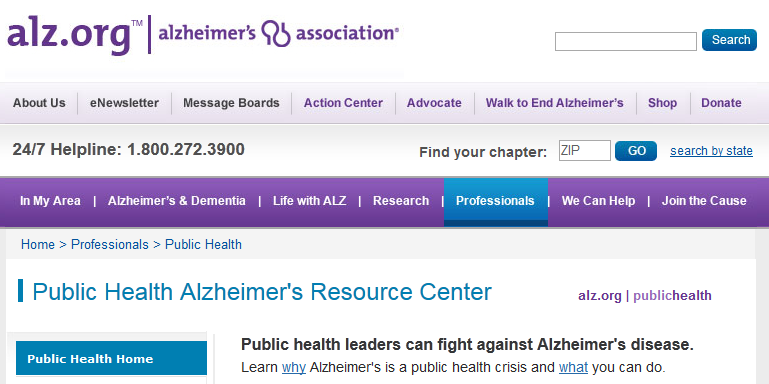| New Report Details Burdens of Alzheimer's Caregiving
 In a new report analyzing caregiver data from the 2010 Behavioral Risk Factor Surveillance System (BRFSS), Alzheimer’s caregivers were shown to be older, provide more intense and longer care for their recipients, and have greater stress and health problems related to their caregiving than non-Alzheimer’s caregivers. One in three Alzheimer’s caregivers reported having a child living in the household in addition to providing care to an older adult, representing what has been called the “sandwich generation.” In a new report analyzing caregiver data from the 2010 Behavioral Risk Factor Surveillance System (BRFSS), Alzheimer’s caregivers were shown to be older, provide more intense and longer care for their recipients, and have greater stress and health problems related to their caregiving than non-Alzheimer’s caregivers. One in three Alzheimer’s caregivers reported having a child living in the household in addition to providing care to an older adult, representing what has been called the “sandwich generation.”
The differences between caregivers of those with Alzheimer’s and those without persisted even when the age of the care recipient was limited to people age 60 and older. This indicates that the differences are not just a function of the age of the care recipient (those with Alzheimer’s disease tend to be older, as advancing age is the greatest risk factor for the disease), but that Alzheimer’s is a particularly burdensome condition. As a result, Alzheimer’s caregivers may need targeted interventions to prevent health problems related to caregiving over longer periods of time.
The data come from the BRFSS Caregiver Module, which is designed to collect information on adult caregivers who care for individuals with a disability or chronic condition. In 2010, five states added the questions to their BRFSS: Connecticut, New Hampshire, New Jersey, New York, and Tennessee. The demographic characteristics of Alzheimer’s caregivers were similar across the five states.
A total of 25 states and the District of Columbia have used the Caregiver Module since it was developed in 2005. For more information on the module, the 2010 report, or Alzheimer’s caregiving, contact Catherine Morrison.
New Public Health Site Goes Live on Alz.org!
 To increase awareness and education about Alzheimer’s as a public health crisis, the Alzheimer’s Association has created a new website dedicated to public health. Check out alz.org/publichealth for the latest news on public health and Alzheimer’s disease, including surveillance information, early detection and diagnosis campaign materials, and the most recent edition of the Public Health E-News. In addition, the website contains numerous educational materials, including an interactive “Brain Tour,” to help public health officials better understand Alzheimer’s disease. To increase awareness and education about Alzheimer’s as a public health crisis, the Alzheimer’s Association has created a new website dedicated to public health. Check out alz.org/publichealth for the latest news on public health and Alzheimer’s disease, including surveillance information, early detection and diagnosis campaign materials, and the most recent edition of the Public Health E-News. In addition, the website contains numerous educational materials, including an interactive “Brain Tour,” to help public health officials better understand Alzheimer’s disease.
November is Both National Alzheimer’s Disease Awareness Month and American Diabetes Month: The Diseases May Share More than the Month of November
Emerging research shows that diabetes may be linked to an increased risk of developing cognitive impairment and dementia, including Alzheimer’s disease. In addition, Alzheimer’s disease complicates the management of other chronic conditions such as diabetes. As reported in the Alzheimer’s Association’s 2012 Alzheimer’s Disease Facts and Figures report, nearly 29 percent of seniors with Alzheimer’s also have diabetes, and seniors with both conditions cost Medicare 81 percent more than seniors with only diabetes.
Scientists do not yet know exactly how Alzheimer's and diabetes are connected, but they do know that excess blood sugar or insulin can harm the brain in several ways:
- Diabetes raises the risk of heart disease and stroke, which hurt the heart and blood vessels.
- Damaged blood vessels in the brain may contribute to Alzheimer's disease.
- The brain depends on many different chemicals, which may be unbalanced by too much insulin. Some of these changes may help trigger Alzheimer's disease.
- High blood sugar causes inflammation. This may damage brain cells and help Alzheimer's to develop.
With this emerging evidence, the public health community has the opportunity to undertake public health campaigns to promote brain health and healthy living practices. By combining diabetes campaigns and brain health promotion messages, public health officials can potentially change the course of two leading causes of morbidity and mortality.
Update on Solanezumab Findings
In updated results released in October, Eli Lilly and Company announced that in a pooled analysis of two Phase 3 studies of its experimental drug solanezumab, there was a statistically significant slowing of cognitive decline in people with mild Alzheimer's disease. This report follows an August announcement by the company that separately, the two Phase 3 trials did not meet both cognitive and functional endpoints. If the pooled result can be duplicated, it suggests that an Alzheimer’s therapy targeting beta amyloid on the brain can have a beneficial effect on cognitive abilities in people with Alzheimer’s.
|